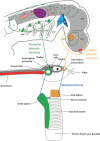The origin and evolution of the ectodermal placodes
- PMID: 22512454
- PMCID: PMC3552413
- DOI: 10.1111/j.1469-7580.2012.01506.x
The origin and evolution of the ectodermal placodes
Abstract
Many of the features that distinguish the vertebrates from other chordates are found in the head. Prominent amongst these differences are the paired sense organs and associated cranial ganglia. Significantly, these structures are derived developmentally from the ectodermal placodes. It has therefore been proposed that the emergence of the ectodermal placodes was concomitant with and central to the evolution of the vertebrates. More recent studies, however, indicate forerunners of the ectodermal placodes can be readily identified outside the vertebrates, particularly in urochordates. Thus the evolutionary history of the ectodermal placodes is deeper and more complex than was previously appreciated with the full repertoire of vertebrate ectodermal placodes, and their derivatives, being assembled over a protracted period rather than arising collectively with the vertebrates.
© 2012 The Authors. Journal of Anatomy © 2012 Anatomical Society.
Figures




References
-
- Baatrup E. On the structure of the corpuscles of de Quatrefages (Branchiostoma lanceolatum (P)) Acta Zool. 1982;63:39–44.
-
- Bailey AP, Bhattacharyya S, Bronner-Fraser M, et al. Lens specification is the ground state of all sensory placodes, from which FGF promotes olfactory identity. Dev Cell. 2006;11:505–517. - PubMed
-
- Baker CV, Bronner-Fraser M. Vertebrate cranial placodes. I. Embryonic induction. Dev Biol. 2001;232:1–61. - PubMed
-
- Bassham S, Postlethwait JH. The evolutionary history of placodes: a molecular genetic investigation of the larvacean urochordate Oikopleura dioica. Development. 2005;132:4259–4272. - PubMed
Publication types
MeSH terms
LinkOut - more resources
Full Text Sources

